I never imagined that a discarded cigar box could be the catalyst for my musical journey. Yet, here I am, strumming a 6 string cigar box guitar that I built with my own hands. The first time I heard its raw, bluesy twang, I was hooked. As an engineer turned luthier, I’ve always been fascinated by the intersection of science and art in instrument making. The 6 string cigar box guitar embodies this fusion perfectly, combining DIY ingenuity with musical tradition. In this comprehensive guide, I’ll share my expertise on how to build, buy, and play these unique instruments. Whether you’re a seasoned musician looking for a new challenge or a curious beginner drawn to the allure of homemade music, you’ll discover the joy of creating and playing your very own cigar box guitar. Get ready to embark on a journey that will transform your understanding of music and craftsmanship.
The History and Evolution of Cigar Box Guitars
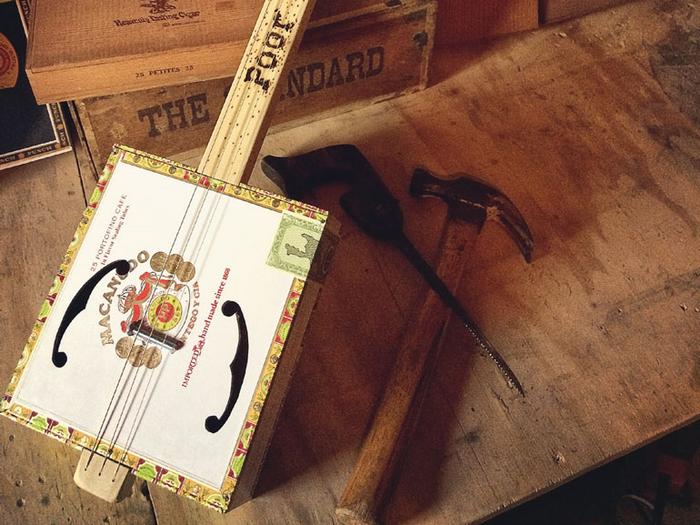
As I reflect on my years of research for the Savart Journal, I’m constantly amazed by the ingenuity behind homemade instruments. The cigar box guitar stands out as a prime example of musical resourcefulness. From plantation fields to modern-day stages, the cigar box guitar has a story that spans over 150 years. But what drove its creation, and how has it evolved? Its origins can be traced back to the mid-19th century when impoverished individuals, particularly in the American South, sought affordable ways to make music.
In my studies, I’ve found that the earliest cigar box guitars were often simple one-string affairs, known as “diddley bows.” These rudimentary instruments gradually evolved, incorporating more strings and refined construction techniques. The Great Depression saw a resurgence in homemade cigar box guitars as people sought inexpensive entertainment. What fascinates me is how this instrument, born out of necessity, has transformed into a beloved icon of DIY culture and roots music.
Today, the cigar box guitar has found its place in various music genres, from blues to rock. As a researcher and enthusiast, I’ve witnessed its journey from a makeshift solution to a respected instrument played by professional musicians. The modern homemade cigar box guitar often features six strings, electric pickups, and intricate designs, showcasing how far we’ve come while still honoring its humble beginnings.
Understanding 6 String Cigar Box Guitar Components
The Body: Choosing the Right Cigar Box

When it comes to the body of a cigar box guitar, my acoustic expertise has taught me that selecting the right box is crucial. The body acts as the instrument’s resonating chamber, directly influencing its tone and projection. I’ve experimented with various cigar boxes, from cedar to mahogany, and each imparts a unique character to the sound. Cedar tends to produce a brighter, more responsive tone, while mahogany offers a warmer, richer sound. The size of the box also matters; larger boxes generally provide more volume and bass response. I always recommend considering the box’s construction too – solid wood boxes typically resonate better than those with particle board. Remember, the body is not just a visual element; it’s an integral part of your instrument’s voice. Choosing the right cigar box can make the difference between a good and a great-sounding guitar.
Neck and Fretboard Essentials

As a luthier with years of experience, I’ve come to understand that the cigar box guitar neck is the heart of the instrument’s playability and sound. It’s where engineering meets artistry. In my designs, I always strive for the perfect balance between strength and comfort. The neck must be sturdy enough to withstand string tension yet slim enough for easy fretting. I typically use hardwoods like maple or mahogany, which offer excellent stability and tonal properties.
The fretboard, often made of rosewood or ebony, is equally crucial. Its radius affects playability, with a flatter radius generally allowing for easier bending. I’ve found that a compound radius can offer the best of both worlds – comfort for chording and ease for lead playing. When it comes to frets, I prefer medium jumbo frets for their versatility. Remember, the neck and fretboard are where your hands meet the music, so every detail matters in crafting a responsive, enjoyable instrument.
Bridge and Tailpiece Options

In my years of researching instrument acoustics, I’ve come to appreciate the critical role of the bridge and tailpiece in a cigar box guitar’s sound. The cigar box guitar bridge is not just a support for the strings; it’s the primary conduit for transferring vibrations to the body. I’ve experimented with various materials and designs, from simple wooden bridges to more complex compensated ones. Each choice impacts tone, sustain, and playability differently.
Tailpiece options range from basic string-through designs to more elaborate trapeze-style attachments. In my experience, a well-designed tailpiece can enhance sustain and provide better tuning stability. I’ve found that the combination of bridge and tailpiece significantly influences the instrument’s overall character, allowing builders to fine-tune their cigar box guitars for specific playing styles or tonal preferences.
Tuners and Strings
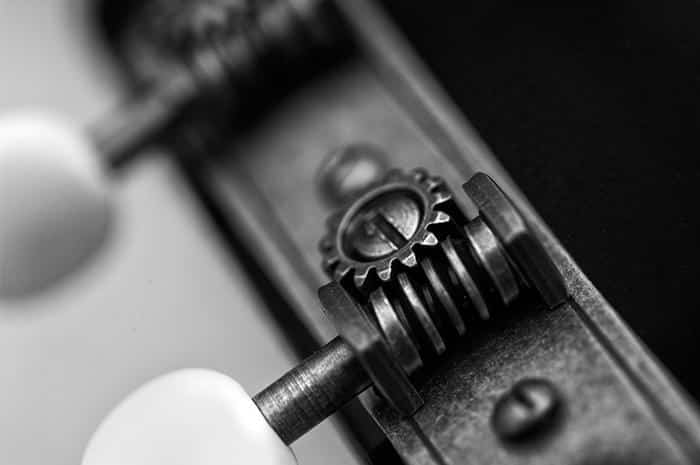
When it comes to tuners and strings, my experience with the New England Luthiers group has taught me their crucial role in a cigar box guitar’s performance. Tuners are the unsung heroes of these instruments, directly affecting tuning stability and playability. I’ve found that quality tuners, while sometimes overlooked, can make a world of difference in maintaining proper cigar box guitar tension.
As for strings, they’re the voice of your instrument. Through extensive experimentation, I’ve learned that string gauge significantly impacts both tone and feel. Lighter gauges offer easier playability but may sacrifice some volume, while heavier strings provide more robust sound but require stronger fretting. It’s a delicate balance, and finding the right combination of tuners and strings can transform a good cigar box guitar into a great one.
Building Your Own 6 String Cigar Box Guitar
Gathering Materials and Tools

As I’ve built countless cigar box guitars, I’ve honed my process for gathering materials and tools. First, I assess what I have on hand and what I need to acquire. For beginners, cigar box guitar kits can be a great starting point, providing pre-selected components and simplifying the build. However, I prefer hand-picking each element for a truly unique instrument.
My essential tools include a saw, drill, screwdriver set, and sandpaper. For materials, beyond the cigar box itself, I source hardwood for the neck, tuning machines, bridge materials, and strings. I’ve learned that investing in quality components pays off in the final product. When selecting wood, I look for straight grain and minimal knots to ensure structural integrity. Remember, the beauty of building your own instrument lies in the ability to customize every aspect to your preferences.
Step-by-Step Construction Process

After gathering all necessary materials, I begin the construction process by carefully reviewing my cigar box guitar plans. My experience has taught me that precision is key, so I always double-check measurements before making any cuts. I start by preparing the cigar box, reinforcing weak spots and cutting sound holes if needed. Next, I focus on the neck, which I’ve found to be the heart of the instrument.
I shape the neck, paying close attention to the fretboard area. Proper fret placement is crucial for intonation, so I use a fret calculator to ensure accuracy. After attaching the neck to the body, I install the bridge and tailpiece. This step requires careful alignment to achieve the correct string action. Finally, I mount the tuners and string up the guitar. Throughout the process, I constantly test and adjust, drawing on my research background to problem-solve effectively.
The final touch is applying a finish to protect the wood and enhance the guitar’s appearance. This step-by-step approach ensures a well-crafted instrument that’s ready for the optional addition of electronics or immediate playing enjoyment.
Adding Electronics (Optional)

Now that we’ve assembled our basic cigar box guitar, let’s explore the exciting world of electronics. As an engineer, I find this step particularly thrilling. Adding pickups and controls can transform your acoustic creation into a fully-fledged cigar box electric guitar. First, choose a pickup that suits your style – single-coil for bright tones or humbucker for a fuller sound. I prefer to mount it near the bridge for optimal string vibration capture. Next, wire in a volume potentiometer and, if desired, a tone control. Don’t forget a 1/4″ output jack for connecting to an amplifier. Remember, proper shielding is crucial to minimize unwanted noise. With these additions, your cigar box guitar will be ready to rock any stage or recording session, offering a unique blend of rustic charm and modern electric capabilities.
Buying a 6 String Cigar Box Guitar
Factors to Consider When Purchasing
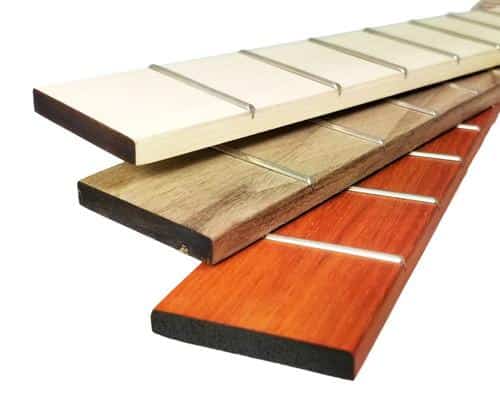
When considering a handmade cigar box guitar, my experience in instrument acoustics guides me to look beyond mere aesthetics. The resonance of the box is crucial; I always tap it gently to assess its tonal qualities. The neck’s stability and straightness are non-negotiable for proper intonation. I pay close attention to the fretwork, ensuring it’s smooth and precisely leveled. The bridge and nut placement significantly impact playability and tone, so I carefully examine their positioning. Action height and string gauge are also key factors I consider, as they affect comfort and sound projection. Remember, a well-crafted cigar box guitar should feel like an extension of yourself. By focusing on these elements, you’ll find an instrument that not only looks unique but also delivers the authentic, raw sound that cigar box guitars are celebrated for.
Top Brands and Models

When it comes to purchasing a 6 string cigar box guitar, I’ve had the privilege of exploring numerous brands through my connections in the lutherie community. C.B. Gitty stands out for their consistent quality and wide range of options. Their “Pure & Simple” model is a fantastic entry-level choice. For those seeking a more premium experience, I’ve been impressed by Hobo Guitars, particularly their “Moonshine” series, which offers exceptional craftsmanship and tone. St. Blues Cigar Box Guitars also deserves mention for their attention to detail and use of high-quality materials. If you’re looking for something truly unique, Daddy Mojo creates stunning custom instruments that are as much works of art as they are musical tools. These brands consistently deliver instruments that capture the essence of cigar box guitar tradition while offering modern playability and sound.
Learning to Play the 6 String Cigar Box Guitar
Tuning and Setup
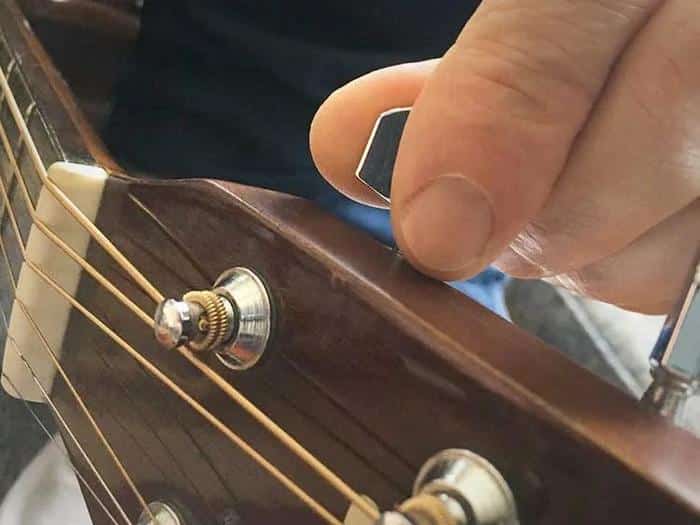
As I delved deeper into the world of cigar box guitar tuning, I discovered that proper setup is crucial for both sound quality and playability. My research into string tension has revealed that finding the right balance is key. Too much tension can make the instrument difficult to play and potentially damage the neck, while too little tension results in poor tone and intonation.
I’ve found that starting with a standard EADGBE tuning works well for most 6-string cigar box guitars. However, experimenting with alternative tunings like open G (DGDGBD) can unlock new sonic possibilities. When setting up your instrument, pay close attention to the action – the height of the strings above the fretboard. A lower action makes fretting easier but can cause buzzing, while a higher action provides cleaner notes but requires more finger strength. Through trial and error, I’ve learned that finding the sweet spot is essential for an enjoyable playing experience.
Basic Techniques and Chord Progressions

As I’ve honed my skills on the 6-string cigar box guitar, I’ve discovered that basic techniques and chord progressions are crucial for any beginner. These unique instruments require a slightly different approach than standard guitars, but the fundamentals remain similar. I always start by teaching simple open chords like G, C, and D, which form the backbone of countless songs.
One of my favorite cigar box guitar instructions involves using a slide. The slide technique is particularly effective on these instruments, allowing for smooth transitions and soulful blues licks. I encourage players to experiment with alternating bass patterns and fingerpicking techniques to add depth to their playing. As for progressions, I’ve found that the I-IV-V pattern works wonderfully on cigar box guitars, especially for blues and folk styles.
Remember, the key is to start simple and gradually build complexity. With practice, you’ll develop a feel for the instrument’s unique voice and be able to create your own signature sound. In the next section, we’ll explore how to maintain your cigar box guitar to ensure it stays in top playing condition.
Maintenance and Care
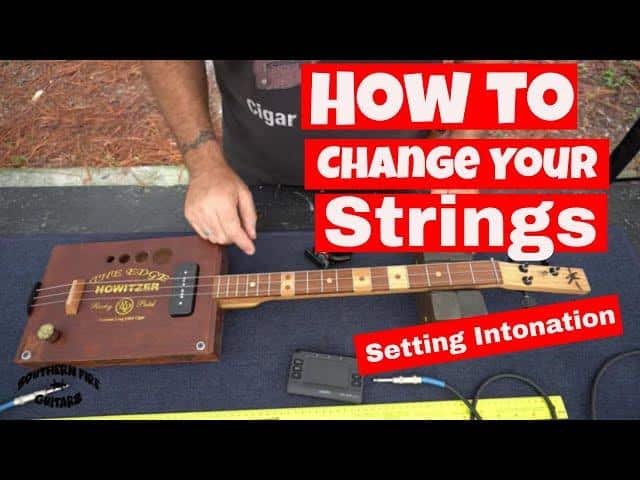
As a luthier with years of experience, I’ve learned that maintaining your cigar box guitar is just as crucial as building or playing it. A well-maintained cigar box guitar can last a lifetime. But what are the secrets to keeping your instrument in top shape? It all starts with understanding the unique characteristics of your instrument.
First and foremost, humidity control is essential. I keep my cigar box guitars in a controlled environment, ideally between 45-55% relative humidity. This prevents the wood from warping or cracking, which can affect both sound quality and playability. I use small humidifiers in dry climates and dehumidifiers in humid areas to maintain this balance.
Regular cleaning is another crucial aspect. I gently wipe down the body and neck with a soft, dry cloth after each playing session to remove oils and dust. For stubborn grime, I use a slightly damp cloth, being careful not to let moisture seep into the wood. The strings require special attention – I clean them with a microfiber cloth to extend their life and maintain tonal clarity.
Lastly, I perform periodic checks on all hardware, including tuners, bridge, and any electronic components. Loose screws or connections can dramatically affect your cigar box guitar’s performance. By following these practices, I’ve kept my instruments in top condition for years, and you can too.
FAQs
What is a cigar box guitar?
What materials do I need to build a 6 string cigar box guitar?
- An empty cigar box
- A wooden neck (often a 1×2 board)
- Six tuning pegs
- A bridge and nut
- Six guitar strings
- Fret wire (optional)
- Basic tools like a saw, drill, and sandpaper
How do I build a 6 string cigar box guitar?
- Cut the neck to size and shape it
- Install the tuning pegs at one end of the neck
- Attach the neck to the cigar box
- Install the bridge and nut
- Add frets if desired
- String the guitar
- Adjust and tune
Remember to measure carefully and take your time with each step.
Where can I buy a 6 string cigar box guitar?
- Online marketplaces like Etsy or eBay
- Specialized cigar box guitar makers’ websites
- Some music stores that carry unique or handmade instruments
- Craft fairs or music festivals where artisans sell their creations
Prices can vary widely depending on the quality and craftsmanship.
How do you play a 6 string cigar box guitar?
- Hold the guitar comfortably, either sitting or standing
- Use your fretting hand to press strings against the fretboard to form chords or individual notes
- Strum or pick the strings with your other hand
- Experiment with different tunings, as many cigar box guitars use open tunings
- Practice basic chords and scales to develop your skills
Remember that the unique construction of a cigar box guitar may require some adjustment to your playing technique.
What kind of music can you play on a 6 string cigar box guitar?
- Blues
- Folk
- Country
- Rock
- Slide guitar music
Its unique sound lends itself particularly well to raw, rootsy styles of music, but with practice, you can adapt it to play almost any genre you enjoy.
Conclusion
The cigar box guitar is more than just an instrument – it’s a gateway to musical creativity and expression. Are you ready to start your journey? As someone who’s dedicated their career to understanding and improving stringed instruments, I can confidently say that the 6 string cigar box guitar represents a perfect blend of tradition, innovation, and accessibility in music making.
Whether you choose to build your own or purchase a ready-made instrument, the 6 string cigar box guitar offers a unique path to musical exploration. Its simplicity belies its versatility, allowing both beginners and seasoned musicians to craft their own sound. From the rich history of blues to modern experimental genres, this humble instrument has proven its worth time and again.
By embracing the 6 string cigar box guitar, you’re not just learning an instrument; you’re joining a community of passionate creators and performers. So pick up that cigar box, grab some strings, and let your musical journey begin. The possibilities are as endless as your imagination.